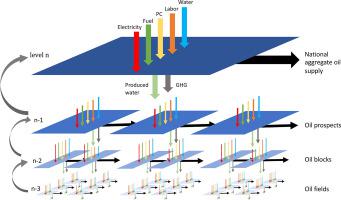Science of the Total Environment ( IF 8.2 ) Pub Date : 2020-09-16 , DOI: 10.1016/j.scitotenv.2020.142371 Rony Parra , Sandra G.F. Bukkens , Mario Giampietro

|
A novel method based on relational analysis is presented for assessing the performance of conventional oil exploitation and its environmental implications, with a focus on the energy-water nexus. It considers the energy system as a metabolic network and integrates various factors relevant for technical, economic and environmental processes, thus avoiding some of the simplifications inherent in conventional approaches to the assessment of primary resource quality, such as economic cost-benefit analysis (CBA) and the energy return on investment (EROI). Relational analysis distinguishes between functional (notional) and structural (tangible) elements in the metabolic network, which allows a simultaneous characterization and geo-localization of the exploitation process across different scales and dimensions of analysis. Key aspects of the approach are illustrated with data from the Ecuadorian oil sector spanning the period 1972–2018. It is shown that by establishing a relation among the characteristics of the exploited oil fields (oil typology, age of field) and those of the exploitation process (requirement of energy carriers, labor, freshwater and power capacity and generation of greenhouse gases and oil-produced water), changes in the performance and environmental implications of the oil extraction system can be characterized at different points in space and time.
中文翻译:

通过关系分析探索老化的常规石油储量对环境的影响
提出了一种基于关系分析的新方法,用于评估常规石油开采的性能及其对环境的影响,重点是能源与水的关系。它把能源系统视为一个代谢网络,并整合了与技术,经济和环境过程相关的各种因素,从而避免了传统的评估主要资源质量的方法固有的某些简化,例如经济成本效益分析(CBA)以及能源投资回报率(EROI)。关系分析可以区分代谢网络中的功能(名义)元素和结构(有形)元素,从而可以在不同规模和分析范围内对开采过程进行同时表征和地理定位。厄瓜多尔石油部门1972年至2018年期间的数据说明了该方法的关键方面。结果表明,通过在已开发油田的特征(石油类型,田地年龄)与开发过程的特征(能源载体,劳动力,淡水和发电能力的需求以及温室气体和石油的产生)之间建立联系,采出水),可以在空间和时间的不同点表征采油系统性能和环境影响的变化。











































 京公网安备 11010802027423号
京公网安备 11010802027423号